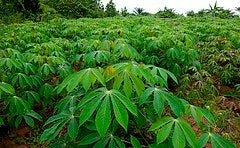
Agriculture is the mainstay of Tanzania’s rural economy and the livelihood of most of the country’s poor. As a result, rural incomes and poverty reduction are closely linked to agricultural productivity. Yet, according to FAO, yields for important staple crops in Tanzania remain very low:
- With a maize yield of 1.3 metric tons per hectare (mt/ha) in 2011, Tanzania ranks behind Kenya and Ghana (1.6 mt/ha); and way behind Vietnam (4.3 mt/ha) or China (5.7 mt/ha).
- A similar pattern holds for rice (paddy), with Tanzania’s yield of 2.0 mt/ha in 2011 being comparable to only about half of Kenya’s (4.0 mt/ha), and less than one third of China’s (6.7 mt/ha) in that year.
- It is noteworthy too that there has been no general upward trend in yields over the past two decades, though there is considerable annual variation due to rainfall patterns.
One key constraint to improved agricultural productivity in Tanzania is the insufficient use of modern inputs, such as fertilizer, improved seeds or pesticides. A powerful reminder of this relationship is India’s Green Revolution of the 1960s and 1970s when significant increases in the use of fertilizer and high yielding seeds, together with investment in irrigation, generated impressive growth in crop productivity. The 2007/8 agricultural census confirmed that the use of improved seeds and chemical fertilizer is also strongly related to maize and paddy productivity in Tanzania. Still, few Tanzanian farmers use modern inputs:
- Only 17 per cent of farm households reported using fertilizer in 2010/11.
- One farmer out of eight reported using pesticides in 2010/11.
- Less than a quarter of crop-growing smallholders in mainland Tanzania were using improved seeds in 2007/08.
The lack of capital faced by most subsistence farmers is the main reason behind their inability to use modern inputs. Removing this financial constraint has traditionally been the goal of most public input promotion schemes, which focus on price subsidies and credit provision. All of these options are being tried in Tanzania, in particular through the National Agricultural Input Voucher Scheme and the Savings and Credit Cooperative Societies (SACCOS).
Nevertheless, trends show that fertilizer use strongly declines when farmers are distant from a road or a market. This highlights the fact that investment in rural road infrastructure and transportation services can go a long way in reducing the costs associated with the distribution of agricultural inputs. Greater connectivity to markets therefore not only improves farmers' access to modern inputs but it also creates new opportunities for agricultural commercialization, which in turn increase incentives to use modern inputs.
- To what extent can low agricultural productivity in Tanzania be explained by the limited use of fertilizer, pesticides, and improved seeds?
- Should the Government scale up the distribution of vouchers for fertilizer and improved seeds? Are the existing programs aimed at helping subsistence farmers use more inputs sustainable?
- Can cash constraints for input purchase be best resolved via agricultural credit, improved savings schemes or improved cellphone-based cash transfers (e.g. from relatives living and working elsewhere)?
- Should more investment be made in rural road and transport infrastructure to facilitate access to inputs, together with greater opportunities for commercialization?
Note: Data on crop production are from the Statistics Division of the FAO (FAOSTAT) while data on input use are from the 2010/11 National Panel Survey and the 2007/08 Agricultural Census. All are publicly available.




Join the Conversation